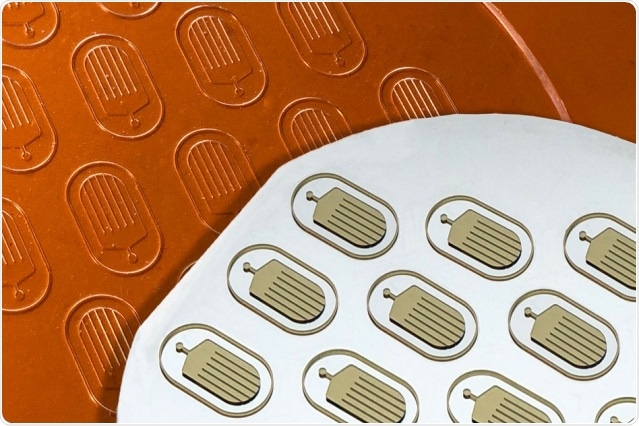Transplanted islet cells that release insulin during very low blood sugar levels offer a potential way of treating diabetes.
But this treatment is not used frequently, because patients receiving such transplants have to take medications to prevent the transplanted cells from being rejected by their immune systems.

MIT researchers have devised a way to encapsulate therapeutic cells, such as pancreatic islet cells, to treat diabetes, in a flexible protective device. Image Credit: Felice Frankel
Hence, to make this kind of treatment more viable, scientists at Massachusetts Institute of Technology (MIT) have recently developed a new method in which the therapeutic cells are encapsulated in a flexible protective device that inhibits immune rejection, while still enabling the crucial nutrients, including oxygen, to reach the cells.
These therapeutic cells can pump out insulin or other types of proteins on demand.
The vision is to have a living drug factory that you can implant in patients, which could secrete drugs as-needed in the patient. We hope that technology like this could be used to treat many different diseases, including diabetes.”
Daniel Anderson, Study Senior Author and Associate Professor, Department of Chemical Engineering, MIT
Anderson is also a member of MIT’s Koch Institute for Integrative Cancer Research and Institute for Medical Engineering and Science.
In a mice study, the scientists demonstrated that the genetically engineered human cells continue to be viable for a minimum of five months, and further assume that these cells may survive for a longer period of time to accomplish long-term treatment of chronic diseases, like hemophilia, diabetes, etc.
Suman Bose is the study’s lead author and a research scientist at the Koch Institute. The study was recently published in the Nature Biomedical Engineering journal.
Protective effect
To maintain their blood sugar levels within a healthy range, type 1 diabetic patients often inject themselves with insulin many times a day.
Since 1999, islet cells have been transplanted to a minimum number of diabetic patients and these islet cells take over their nonfunctioning pancreas.
Although the treatment is usually effective, the immunosuppressant drugs that are taken by these patients make them rather susceptible to infections and lead to other adverse side effects.
For many years, Anderson’s laboratory has been looking for ways to guard transplanted cells against the host’s immune system, so that immunosuppressant medications would no longer be required.
We want to be able to implant cells into patients that can secrete therapeutic factors like insulin, but prevent them from being rejected by the body. If you could build a device that could protect those cells and not require immune suppression, you could really help a lot of people.”
Daniel Anderson, Study Senior Author and Associate Professor, Department of Chemical Engineering, MIT
To guard the transplanted cells against the host’s immune system, the scientists integrated them into a device that was constructed from a silicon-based elastomer (polydimethylsiloxane) and a unique porous membrane.
“It’s almost the same stiffness as tissue, and you make it thin enough so that it can wrap around organs,” stated Bose.
The researchers subsequently coated the device’s exterior surface with a small-molecule drug known as THPT. In earlier research, the researchers found that this THPT molecule can help inhibit fibrosis, which is an accumulation of scar tissue that occurs when foreign objects are attacked by the immune system.
The device comprises a porous membrane that enables the transplanted cells to get oxygen and nutrients from the bloodstream. Such pores should be sufficiently large to enable the passage of insulin and nutrients but should be small enough to ensure that immune cells like T cells do not penetrate and attack the transplanted cells.
In this analysis, the scientists examined polymer coatings, with pores ranging between 400 nm and 3 µm in diameter, and they noted that a size range of 800 nm to 1 µm was ideal.
At this size, while oxygen and tiny molecules can pass through, T cells cannot. So far, it had been assumed that the pores measuring 1 µm would be very large to prevent cellular rejection.
Drugs on demand
In research performed on diabetic mice, the team demonstrated that when microdevices were integrated with transplanted rat islets, normal blood glucose levels in the mice were maintained for over 10 weeks.
The scientists even applied this method to human embryonic kidney cells that were designed to release erythropoietin (EPO)—a type of hormone that supports the production of red blood cells and is used for treating anemia. Such therapeutic human cells lasted in mice for at least 19 weeks of the experimental period.
“The cells in the device act as a factory and continuously produce high levels of EPO. This led to an increase in the red blood cell count in the animals for as long as we did the experiment,” added Anderson.
The scientists also demonstrated that they can possibly program the transplanted cells to create a protein only in relation to a treatment using a small molecule drug. EPO was specifically produced by the transplanted engineered cells when the doxycycline drug was injected into mice. This method could enable on-demand production of a hormone or protein only when it is required
This type of “living drug factory” can prove handy for treating all types of chronic disease that need regular doses of a hormone or protein, stated the scientists. At present, the team is focusing on diabetes and looking for ways to prolong the lifespan of the transplanted islet cells.
This is the eighth Nature journal paper our team has published in the past four-plus years elucidating key fundamental aspects of biocompatibility of implants. We hope and believe these findings will lead to new super-biocompatible implants to treat diabetes and many other diseases in the years to come.”
Robert Langer, Study Author and David H. Koch Institute Professor, MIT
Source:
Journal reference:
Bose, S., et al. (2020) A retrievable implant for the long-term encapsulation and survival of therapeutic xenogeneic cells. Nature Biomedical Engineering. doi.org/10.1038/s41551-020-0538-5.